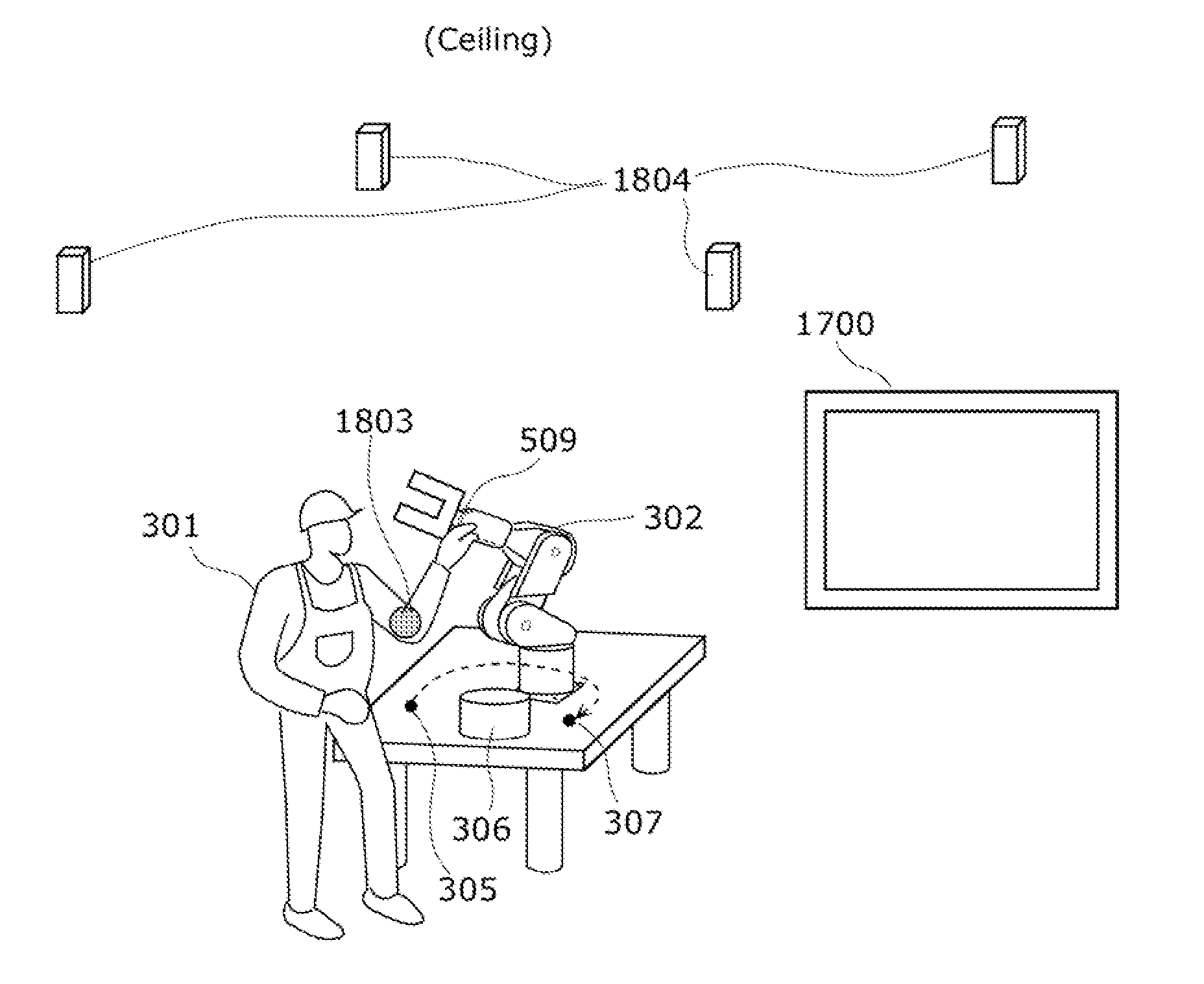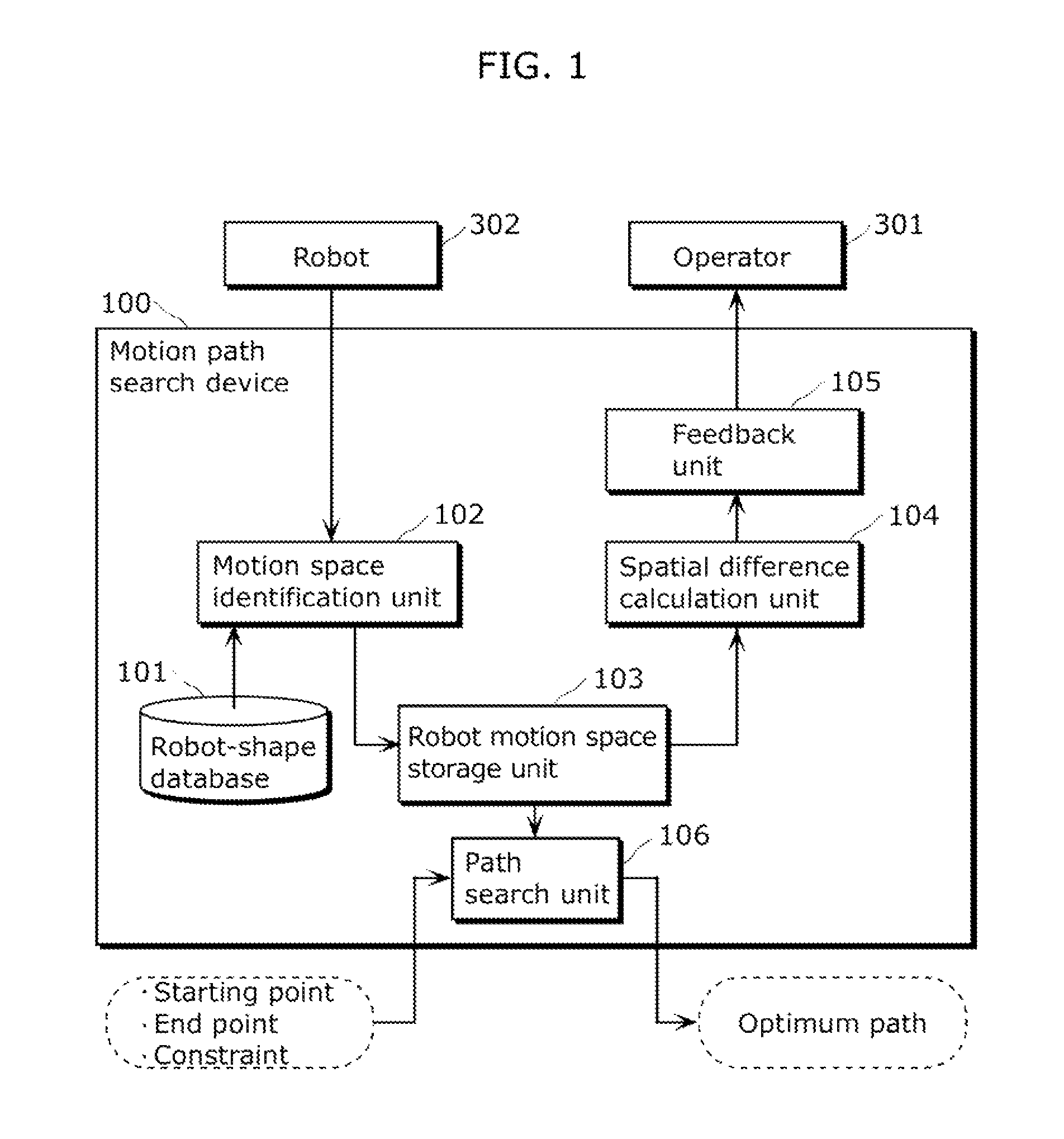Motion path search device and method of searching for motion path
a technology of motion path and search device, which is applied in the direction of electric programme control, instruments, program control, etc., can solve the problem of difficulty in determining a motion path with higher optimality, and achieve the effect of efficient expansion of an accessible spa
- Summary
- Abstract
- Description
- Claims
- Application Information
AI Technical Summary
Benefits of technology
Problems solved by technology
Method used
Image
Examples
embodiment 1
[0071]FIG. 1 is a block diagram showing a basic functional configuration of a motion path search device 100 in Embodiment 1. As shown in FIG. 1, the motion path search device 100 includes a robot-shape database 101, a motion space identification unit 102, a robot motion space storage unit 103, a spatial difference calculation unit 104, a feedback unit 105, and a path search unit 106.
[0072]The robot-shape database 101 stores robot-shape data indicating the shape of a robot 302 which performs automated operation.
[0073]The motion space identification unit 102 corresponds to a first space identification unit. The motion space identification unit 102 identifies, as a first space (hereinafter referred to as a “robot motion space”), a three-dimensional space swept through by a movable part in each direct teaching operation.
[0074]Specifically, the motion space identification unit 102 identifies a three-dimensional space occupied by the robot 302 at points of time in direct teaching, based o...
embodiment 2
[0142]Embodiment 2 of the present disclosure shall be described below with reference to the drawings. The description of the part in common with Embodiment 1 will not be repeated herein.
[0143]A motion path search device 1700 in Embodiment 2 is different from the motion path search device 100 in Embodiment 1 mainly in that the motion path search device 1700 also uses a space swept through by the body of the operator 301 in direct teaching as a search space for a motion path.
[0144]FIG. 17 is a block diagram showing a basic functional configuration of the motion path search device 1700 in Embodiment 2. The components in common with those in FIG. 1 are denoted with the same reference signs in FIG. 17 and the description thereof is not repeated herein.
[0145]As shown in FIG. 17, the motion path search device 1700 includes a robot-shape database 101, a motion space identification unit, 102, and a robot motion space storage unit 103 as is the case with the motion path search device 100 in E...
embodiment 3
[0202]Embodiment 3 of the present disclosure shall be described below with reference to the drawings. The description of the part in common with Embodiment 2 will be omitted herein as appropriate.
[0203]A motion path search device according to Embodiment 3 is different from the motion path search device in Embodiment 2 in that the information to be provided to the operator 301 varies depending on a result of comparison between a first differential space and a second differential space. The functional configuration of the motion path search device in Embodiment 3 is not illustrated in the drawings because it is in common with that in Embodiment 2.
[0204]In Embodiment 3, a feedback unit 1709 provides one of information regarding a first differential space and information regarding a second differential space depending on a result of comparison between the first differential space and the second differential space. Specifically, the feedback unit 1709 provides information regarding the f...
PUM
 Login to View More
Login to View More Abstract
Description
Claims
Application Information
 Login to View More
Login to View More - R&D
- Intellectual Property
- Life Sciences
- Materials
- Tech Scout
- Unparalleled Data Quality
- Higher Quality Content
- 60% Fewer Hallucinations
Browse by: Latest US Patents, China's latest patents, Technical Efficacy Thesaurus, Application Domain, Technology Topic, Popular Technical Reports.
© 2025 PatSnap. All rights reserved.Legal|Privacy policy|Modern Slavery Act Transparency Statement|Sitemap|About US| Contact US: help@patsnap.com



